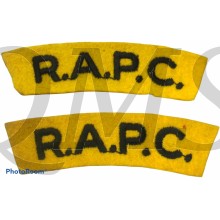Shoulder flashes Royal Army Pay Corps (R.A.P.C.)
The first "paymasters" have existed in the army before the formation of the corps. Prior to the 19th century, each regiment had its own civilian paymaster and the first commissioned paymaster was introduced in 1792. In 1870 a Pay Sub-Department of the Control Department was formed before it was organised into a corps. Before the end of the First World War the Corps was known as the 'Army Pay Corps'. The prefix 'Royal' was added in recognition of valuable services provided during the War.
In 1919 the financial responsibilities were split between the RAPC, which handled salaries, and the Corps of Military Accountants (CMA), which handled the army's finances. The CMA was disbanded in 1925 and its functions and some personnel were transferred to the RAPC.
Before the Second World War, the RAPC did not accept recruits directly from civilian life, but only transfers from serving soldiers who had been in the Army for at least six months. During the Second World War, members of the Auxiliary Territorial Service and men of a "lower medical category" were often conscripted into the corps. Initially they received very little military training but after a discussion in Parliament were trained in armed combat, especially for those posted closest to the frontlines, to prepare for surprise attacks on headquarters. With the amalgamations into the Adjutant General's Corps in 1992, its functions are now carried out by the Staff and Personnel Support (SPS) Branch.



